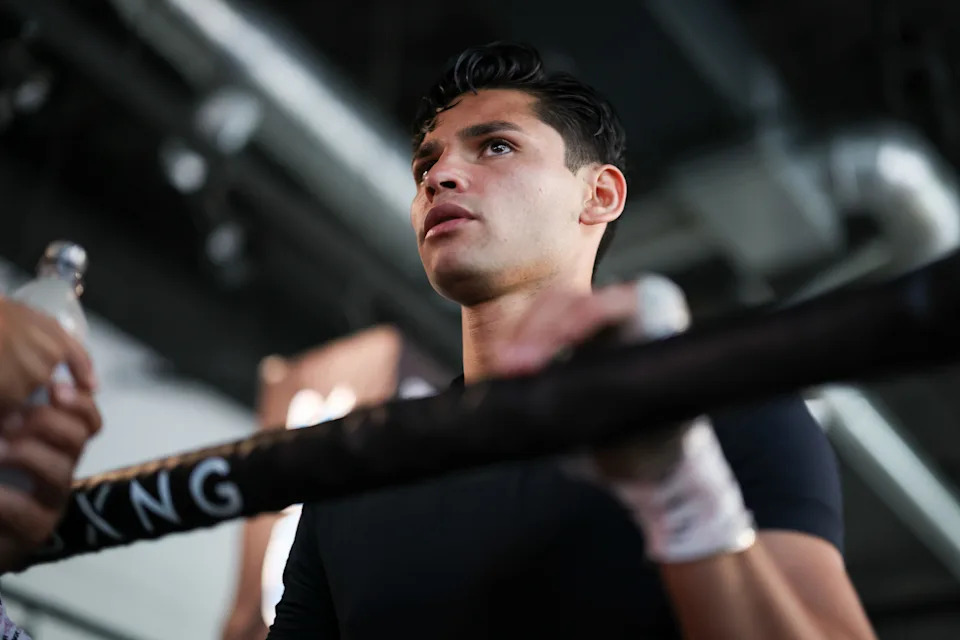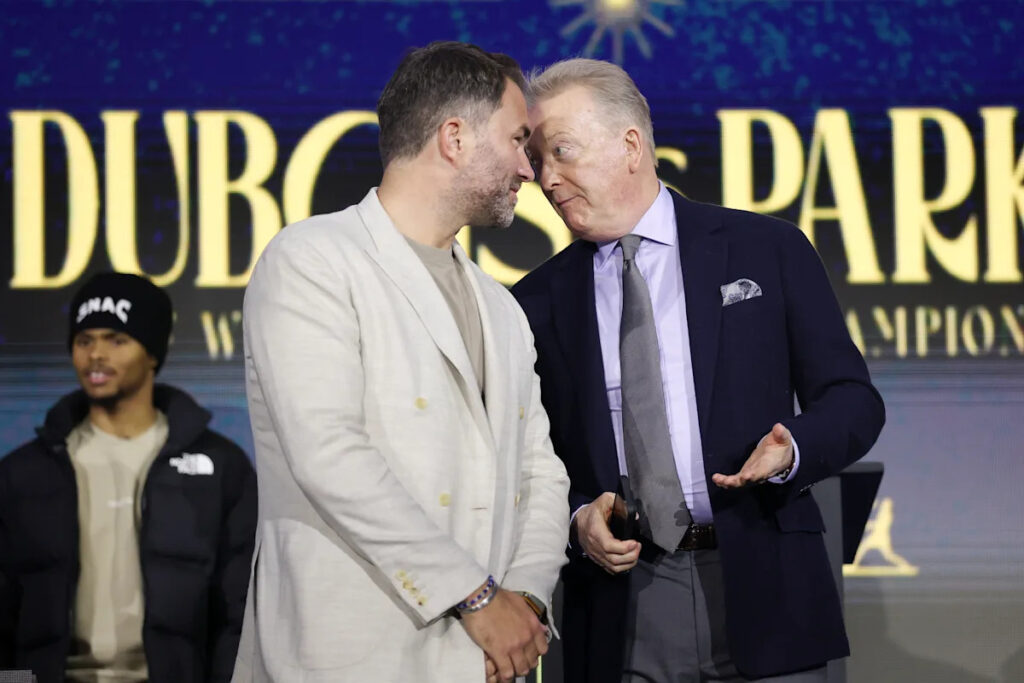Boxing has always thrived on rivalries.
From Muhammad Ali’s thunderous all-time trilogy with Joe Frazier to Manny Pacquiao’s epic four-fight series with Juan Manuel Marquez, these weren’t just contests — they were crucibles. They were high-pressure clashes that pushed extraordinary men to limits they didn’t previously know they had — and, in doing so, elevated themselves, and the sport as a whole.
Advertisement
Rivalries like these are the heartbeat of boxing — where champions are crowned, legacies are forged, and eras are defined.
Now, a new rivalry is taking shape.
This one, though, won’t be fought under bright Las Vegas lights or to the sound of a bell in front of 17,000 ticket-paying fans, but behind-the-scenes in the boardrooms of powerful sports execs. If done right, it could become the latest Fight of the Century — not Ali vs. Frazier, not Pacquiao vs. Marquez, but White vs. Arum, and Alalshikh vs. Haymon. The stakes here outstrip world championship belts as this blockbuster bout could determine boxing’s survival, and its identity, with the soul of the sport potentially up for grabs.
In one corner stand the old guard: Al Haymon, Bob Arum, Oscar De La Hoya and their international counterparts. These men have been the architects of modern boxing as their fingerprints smudge every great fight of the last half-century. Yet the empires they spent years — decades — building are crumbling. Once-mighty broadcast checks of $100 million per annum have been whittled to scraps — $50 million, even $10 million, according to an Uncrowned source citing knowledge of an offer that one promoter received from TNT Sports. Their rosters still dazzle — Gervonta “Tank” Davis, Naoya Inoue and Ryan Garcia — but the financial scaffolding holding it all together is turning to rust.
Advertisement
In the other corner is the brash upstart: TKO, fronted by Dana White, financed by Turki Alalshikh’s billions, and emboldened by UFC’s new seven-year broadcast deal worth $7.7 billion from CBS Sports and Paramount. TKO isn’t entering boxing to take part. It wants to take over. It intends to rewrite the script — with its own belts, rankings and league, if Congress signs off on an Ali Act Revival bill that its political allies are pushing.
It doesn’t have to break boxing.
Like Ali vs. Frazier, and like Pacquiao vs. Marquez, it can actually strengthen it — but only if the sport’s old guard does the improbable by putting aside their egos, and unifying.
Manny Pacquiao and Mario Barrios collided in one of the biggest U.S. boxing matches of the year.
(Anadolu via Getty Images)
Enter: The World League of Boxing
The solution has been staring boxing in the face for years: Not splintering further, but consolidating.
Advertisement
The sport’s titans — Haymon, Arum and De La Hoya in the U.S.; Eddie Hearn and Frank Warren in the U.K.; Akihiko Honda and Hideyuki Ohashi in Japan; Fernando Beltran in Mexico — must join forces under one banner for a World League of Boxing.
Here is my proposal:
Annual Structure
-
January — Champion’s Showcase: A victory-lap super-card starring boxers from the previous season’s winning promoter, typically in their home territory (e.g Teiken in Tokyo, or Top Rank in Las Vegas).
-
February — Boxing Combine & Draft: Fighters enter the first true “sports combine” in boxing history. Punch power (from jabs, hook shots and straights) is measured on sensors like the Power Kube. There are bag circuits for endurance tests. And reflexes can be measured on boards for speed.
-
Rising stars, free agents, and League commissioner signings then enter the draft. The lowest-ranked promoters from the previous season pick first — leveling the playing field and ensuring fresh rivalries.
-
-
March — Opening Ceremony: A global spectacle like the Oscars, rotating between key cities like Vegas, London, Tokyo and Mexico City. Promoters unveil their chosen fighters for the season’s league, and the League commissioner reveals the regular season’s schedule. At the end of the show, the first bell rings with a season opener featuring a commissioner-chosen bout.
-
April–October — Regular Season: Each month, promoters collide in marquee cities in each promoter’s territory. Every fight counts. Wins earn three points, draws yield one, and losses get nothing. Fans can follow a simple league table, just like football or basketball. Rivals don’t duck each other — they’re locked into a system that guarantees quality fights. Each division carries its own fixtures, with points from flyweight to heavyweight all adding to a promoter’s league tally.
-
Midseason Trade Window (optional): Promoters can loan a fighter to another stable during an optional trade window, albeit one that asks strategic questions. This is because a loaned fighter can only earn a maximum of two points for their new promoter, with one point automatically kicking back to their original representative. Promoters can also trade draft picks as currency — swapping a future first-round pick for a one-off star. This format sees rivals suddenly talk each other’s fighters up. Imagine Top Rank loaning Teofimo Lopez to PBC for a headline clash against Matchroom’s Conor Benn. Or Teiken lending Ryusei Matsumoto to Zanfer so they can honor their minimumweight obligation in an event against Golden Boy’s Oscar Collazo.
-
November — Playoffs: The top four promoters advance to semifinal cards in one of the league’s major host cities.
-
December — Final: The top two promoters of that year box their best fighters in one of the biggest nights modern boxing has staged — the league championship.
-
Flexibility Built In: Unlike past tournaments that collapsed when injuries struck (remember the Super Six World Boxing Classic), the World League’s season format makes every picked fighter a part of a promoter’s larger squad. A loss doesn’t lead to eliminations, and injuries don’t cause delays. Promoters can rotate prospects, champions, and stars throughout the year to keep the season alive, the calendar intact, and the fans engaged. WBA, WBC, WBO and IBF world titles can be defended at any point during the season, or post-season.

Ryan Garcia remains one of the biggest stars in U.S. boxing.
(Cris Esqueda/Golden Boy via Getty Images)
Economics
-
One rights deal for one product: Fractured broadcast contracts are a thing of the past because, in this vision, the league sells a unified global calendar to command bigger checks and mainstream attention.
-
Performance-based payouts: Promoters earn more if their fighters win and their events sell. Winning pays.
-
Fighters are guaranteed activity: Every boxer signed up to each season is booked for a minimum of one fight a year, but preferably competes more. Each promoter puts forward their proposed fighters for a divisional matchup, with the commissioner having final say. Purses are standardized by ranking, bringing stability to careers too often left waiting.
Governance
-
Executive Commissioner: This exec runs the league like a sports CEO. Candidates could include Stephen Espinoza (the TV dealmaker), Kalle Sauerland (a boxing innovator) or Kathy Duva (the seasoned stateswoman).
-
Fighters’ Commissioner: This exec protects the athletes. Names like Mike Tyson, Wladimir Klitschko or Evander Holyfield lend mainstream credibility, legacy and fighter-first legitimacy.
-
Accountability: An independent rules committee would review judging and officiating disputes to ensure consistency. In a bid to further transparency, the league would host an “Ask the Judges” Q&A session after controversial fights, where judges have to defend their scorecards in front of the media.
Two Big Questions
Q: Why would stars pick the League over Turki/TKO?
A: The League out-structures one-night site fees across a year because it can guarantee activity with a minimum of one to two fights during the regular season, with additional dates available if a stable advances to the playoffs, and the final. A League would distribute a defined media-rights income pool to champions and A-list fighters. This level of revenue transparency is what’s missing from TKO’s upcoming venture in boxing should it create a UBO, according to critics of The Muhammad Ali Revival bill. Cross-promotional fixtures force fights that build pay-per-view value — a mirror to previous boxing tournaments like the Super Six Boxing Classic that propelled Andre Ward’s career, and the World Boxing Super Series (WBSS) which progressed the careers of both Naoya Inoue and Oleksandr Usyk. A League would not replace TKO, or Riyadh Season, but provide competition to it. Fighters signed up to one season would be exclusive to the League for that year alone, and free to compete in TKO events, or Riyadh Season, thereafter, as the League rotates the weight classes for each season.
Advertisement
Q: Is this a new GFL fight league except for boxing?
A: No — this is an overlay, not a single-entity. Fighters stay with their promoters. The League would schedule inter-promoter fixtures, and award points to promoter standings to incentivize stables to make the fights. It’s a squad model so that injuries don’t postpone or nix critical contests, as replacements can be sought to save a prospective PBC vs. Matchroom event, or a Zanfer vs. Golden Boy show. It plays into the current boxing ecosystem with fighters bringing WBA, WBC, WBO and IBF world championship belts into the League to defend in the season. It is more akin to an evolved WBSS, than MMA’s ill-fated Global Fight League.
Why It Matters
The World League of Boxing would:
Advertisement
-
Guarantee fighters with steady paydays, activity and real stakes.
-
Guarantee fans the rivalries and narratives that they’ve been denied for years.
-
Guarantee a broadcast partner with a clear, global calendar that has the potential to sell better than individual deals with standalone events.
This wouldn’t erase individuality as each promoter brings their personality, scouting networks and regional pride to the league and its events. Together, they’re a match for TKO. Alone, they aren’t.
Boxing has always thrived on rivalries and next may be one of the biggest: TKO vs. the world.
If the old guard can unify, they won’t just survive the oncoming “power grab.” They’ll thrive — and like every great rivalry before it, the true winner will be the sport itself.
Read the full article here



